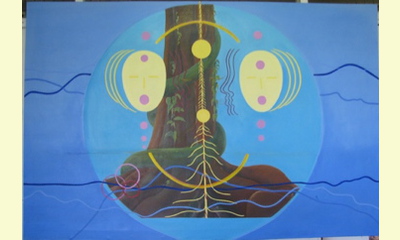|
|
Art for Individual Transformation
an article by Akima McPherson
Believing that art can be used as an effective change agent, I have explored the synchronicities between Christianity and Hinduism in painting. I am a visual artist from Guyana on the northern South American coast. Guyana is a country with an interesting history of migration and an often-overlooked contemporary situation. With a population of approximately 750,000 people, the majority of Guyanese are either of Indian or African descent. However, the systems of colonialism has pitted the two groups against each other and today, after 46 years of Independence, one can still witness subtle manifestations of this. 
In Tandem III
click on photo to enlarge
In the paintings that form the In Tandem series, I attempt to merge elements of Chakra philosophy (an aspect of Hindu philosophy) with elements of Christianity. My aim is to make visual the commonalities between the two religions. I was motivated in doing this as I feel an element of the racial tensions experienced by Guyanese daily, which is further amplified during election periods, is religious intolerance. This is a direct outcrop of a lack of understanding of Hinduism by Christians and a failure to recognize in what ways the two religions are common.
However, my imagery is deliberately not literal and does not incorporate the usual symbols of either religion. Instead, my references are deliberately subtle to encourage a dialogue with self that can aid a viewer-participant in a process of increased self-awareness as they become conscious of their questions, their responses, and the nature of the internal dialogue. Colour is a deliberate consideration to encourage an interaction of a meditative quality. Ultimately, my aim is to encourage meditation and harmonizing with self to encourage a soulful, peaceful conscious way of being. The consequence of this I believe is conscious, peaceful living with others.
|








|
DISCUSSION
Question(s) related to this article:
Artistic expression,, Can it help us understand the values of other groups and peoples?
* * * * *
Latest reader comment:
CPNN has received the following addition to the article about Samrup Rachna from its author, Dr Anwer
How common language and common values , common hoistry , common heritage and common collective behaviours of the people of South Asia ( India and Pakistan ) can be utilized to bring them closer to achive common goal of peace and prosparity . The effort to highligh these commonalities is explained in a lecture on his forth comming book by Dr Anwer titled " Apni Boli Apna Samj" our own language and culture .
Kuch Khaas: Calligraphic Expression of Apni-Boli
Highlighting the commonalities between India and Paksitan will bring the people closer ? Our Language ( Hindi-Urdu) and our Smaj ( Culture+Society+Traditions) are same then where is the the problem ?

|
|









